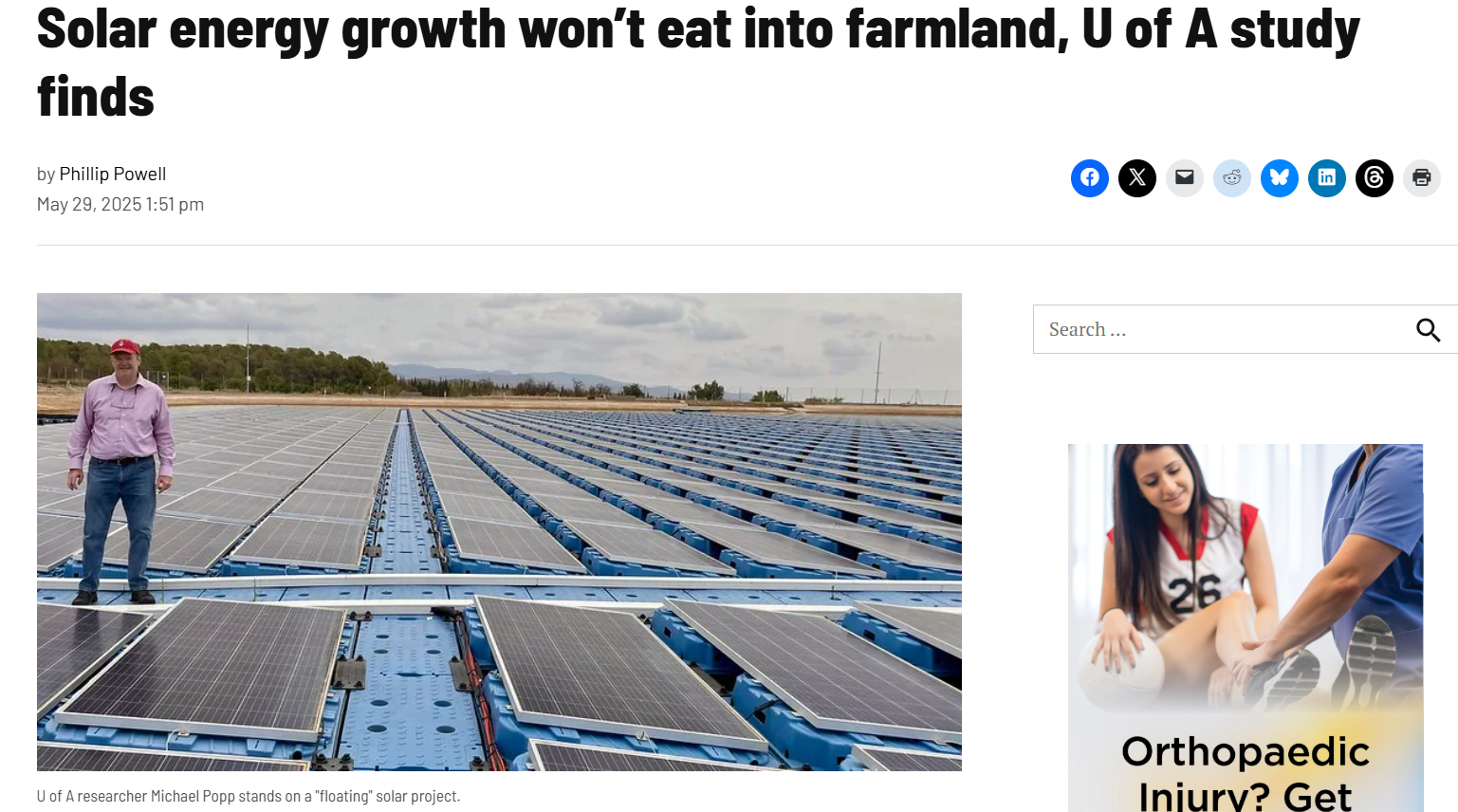Solar energy growth won’t eat into farmland, U of A study finds - Arkansas Times
Article link: Michael Popp
May 30, 2025
Article Highlights
Minimal Impact on Farmland:
Even with a rapid expansion of solar energy in Arkansas, only 0.2% to 1% of the state’s total farmland will likely be affected by solar installations.
By 2026, solar projects are projected to use 22,000 to 35,000 acres of agricultural land (out of 13.7 million total farmland acres).
Economic Opportunity for Farmers:
Solar leases on agricultural land can generate up to $2,500 per acre annually for landownersSolar projects, like agrivoltaics, allow dual-purpose land use, such as combining solar energy harvesting with livestock grazing.
Innovative Solutions:
Floating solar systems can coexist with irrigation setups, benefiting water-intensive crops like rice.
Agrivoltaic arrangements are gaining traction but show mixed success with row crops such as soybeans, corn, and rice.
Steady Growth of Solar Power in Arkansas:
Utility-scale solar systems have significantly increased since 2019, with 1,100 megawatts added to the power grid in 2022 and another 400 megawatts expected this year.
Renewable sources supplied approximately 9% of Arkansas’s energy needs in 2023.
Future Considerations:
Studies are needed on how solar leases might influence farmland rental rates and land prices.
Expanding solar energy presents both economic and environmental opportunities for the region.
Conclusions from the Study
Solar energy expansion is not a threat to agriculture in Arkansas but an opportunity for diversification.
Farmers can use photovoltaics (PV), agrivoltaics, and floating photovoltaic systems to enhance income and improve irrigation practices.
For more details, access the full research breakdown here Download FSA1105.
Full article: Solar energy growth won’t eat into farmland, U of A study finds - Arkansas Times
Charting a Sustainable Path Forward with Solar and Agriculture in Arkansas
The University of Arkansas study offers clear, data-driven reassurance to a conversation often mired in uncertainty and misconception. The research demonstrates that even ambitious growth in solar infrastructure will utilize a minuscule percentage of Arkansas’s farmland. Less than 1% of the state’s agricultural acreage would be impacted, even under the most aggressive development scenarios.
This fact is not simply encouraging; it is a call for us as partners in Arkansas’s future to rise above fear and focus on possibility. Too often, we allow apprehension to color our approach to innovation, especially when it comes to changes in the rural landscape. But as this study underscores, solar development is not a threat to the agricultural foundation of our communities—instead, it represents an opportunity.
By viewing renewable energy as complementary to agriculture rather than as a competitor, we unlock new modes of resilience for our farmers. Leasing land for solar projects creates crucial avenues for income diversification, a reliable stream that can empower growers to invest confidently in their land and operations. The emergence of agrivoltaics, where energy generation and farming coexist, further demonstrates how progressive stewardship can benefit both the land and the livelihoods of those who farm it. Floating solar arrays above irrigation systems represent another possibility-filled frontier, merging sustainability with the vitality of Arkansas’s agricultural heritage.
We must also acknowledge the responsibility that comes with innovation. The report rightly notes the need for ongoing study into land prices and rental dynamics, ensuring that economic benefits are widely shared and that agriculture remains accessible for new generations. It is through thoughtful, collaborative engagement that we ensure positive outcomes for the greatest number.
The broader lesson for Arkansas and beyond is this: We are not forced to choose between a robust agricultural sector and a renewable energy future. Our greatest impact comes from thinking beyond today’s debates and investing in partnerships that honor both the land and those who steward it.
Together, we can cultivate an Arkansas where solar power and farming do not merely coexist, but thrive, sustaining our environment, our economy, and our shared legacy for generations to come.
Full article: Solar energy growth won’t eat into farmland, U of A study finds - Arkansas Times
See Brianna’s press kit for speaking topics and credentials: https://www.lightstar.com/press-kits
Contact Meghan Welborn, Director of Marketing & PR for press inquires and speaking enagagements for Brianna and the Lightstar team.


